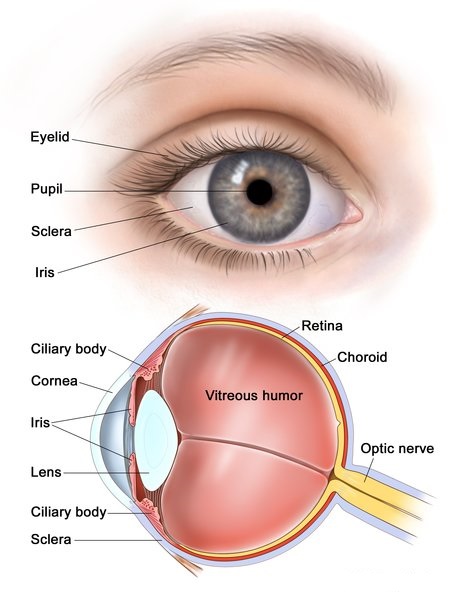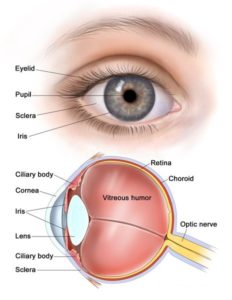
What is coloboma? Treatment, Disease and Symptoms
July 5, 2019Table of Contents
What is coloboma?
Coloboma is an eye defect. The name of the disease is based on the Greek word koloboma, which means “defect” or “mutilated”.
Coloboma disease is used to describe an eye abnormality, which occurs before birth, and results in missing pieces of tissues in the structures that end up forming the eye.
Coloboma can affect different structures of the eye and are referred to as much, for example, coloboma of eyelid and coloboma of iris. It is caused by complications during the embryonic development of the fetus. It can affect only one eye or both of them.

People who suffer from the coloboma disease experience a different type of vision due to due to their eyes being structured differently and usually have to make lifestyle adjustments to live with the vision problem. The placement of the coloboma may affect the individual’s ability to focus. Coloboma of iris makes the iris very sensitive to bright light, which leads to patients having difficulty staying outdoors in the sun.
In this blog, we’re going to take a look at the disease, understand its types and know more about coloboma treatment in India.
Coloboma and its Types
Coloboma appears as notches or gaps in parts of the eye like the iris, the retina, or even the optic nerve. Depending on the structure of the eye affected by coloboma disease, coloboma may be classified into the following types:
- Eyelid coloboma – in which a piece of the upper or the lower eyelid is missing.
- Lens coloboma – in which the lens in the eye is missing tissue.
- Macular coloboma – in which a part of the macula isn’t fully developed.
- Optic Nerve coloboma – in which the optic nerve is hollowed out because of the coloboma disease, which leads to a loss in vision.
- Uveal coloboma – in which tissue is missing from the uvea, which is the middle layer of the eye.
- Retinochorodial coloboma – in which a part of the retina is missing.
Regardless of the type of coloboma, it increases the risk of the following:
- Retinal detachment – delicate tissues at the back of the eye can pull or break due to a weakened structure of the eye.
- Glaucoma – coloboma can lead to an increased intraocular pressure leading to a higher risk of glaucoma.
- Cataract – coloboma disease can cause a cataract to form, even at younger ages.
Causes of Coloboma
Coloboma is caused due to abnormal development of the eye. Ideally, during the second month of growth in a fetus, a seam called the optic fissure is closed, which leads to forming the structures that create the eyes eventually. Incomplete closure of the optic fissure results in coloboma or gaps in the structures that form the eye.
As the optic fissure closes typically at the bottom of the eyeball during development, coloboma disease usually affects the lower half of the eye. The structure affected by coloboma disease depends on the part of the optic fissure that failed to close during the development of the fetus.
The disease may be affected by changes to the genes that are involved in the early development of the eye; they are not completely identified yet. Other causes of coloboma include chromosomal abnormalities that may affect one or more genes.
Environmental factors also play a role in affecting coloboma, such as exposure to alcohol during pregnancy.
Coloboma Symptoms
People who suffer from coloboma usually suffer from other eye problems like the following:
- Clouding of the inner lens of the eye (cataracts).
- Increase intraocular pressure (glaucoma).
- Vision problems such as myopia, hyperopia, or astigmatism.
- Involuntary back-and-forth eye movements which are known as nystagmus.
- Separation of the retina from the back of the eye, especially seen in retinochoroidal coloboma.
Coloboma Treatment
- Most people with iris coloboma require no treatment and are often prescribed a special contact lens that covers the gap in the iris and gives the eye a normal appearance and reduces light sensitivity.
- Unfortunately, for other types of coloboma, there is no treatment as of date. However, the diseases associated with coloboma like retinal detachment, cataract, glaucoma can all be treated or controlled.
- It is highly important for people who suffer from coloboma to get regular eye examinations to track any changes to their eye health. If a person suffering from coloboma experiences a new symptom or has any concerns should visit their ophthalmologist instantly.
- Even though glasses and contact lenses do not treat coloboma, children suffering from coloboma and refractive errors should be provided with glasses to ensure their focusing problems are corrected in order to develop a healthy sight.
- Tinted glasses or sun blinds in the car may help reduce the light sensitivity experienced by people who suffer from the coloboma disease.
A Rare Eye Disease
Coloboma is a relatively rare eye disease affecting only a small percentage of the population. Even though most forms of the disease aren’t treatable, a person suffering from coloboma can still live a happy and fulfilled life. To know more, contact your ophthalmologist today!

